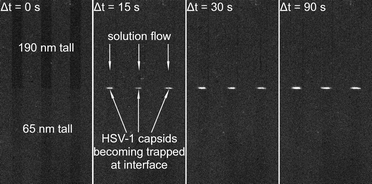Nanofluidic systems offer advantages for chemical analysis, including small sample volumes, size-selective particle trapping, sample concentration and the ability to separate and detect single molecules. Such systems can be fabricated using planar nanochannels, which rely on standard photolithographic techniques. Nanochannel fluid flow can be driven by capillary action, which benefits from simple injection and reasonably high flow rates. We demonstrate an analysis chip fabricated with planar nanochannels that consist of two adjoining segments of different heights. When nano-analytes elute through the channel, they become physically trapped when the channel dimensions shrink below the size of the particles. We demonstrate the capability of these devices to trap and concentrate by using the following: 120-nm polymer beads, 30-nm polymer beads, Herpes simplex virus 1 capsids, and hepatitis B virus capsids. Each species was fluorescently labeled and its resulting fluorescent signal was detected using a cooled CCD camera. We show how the signal-to-noise ratio of trapped analyte intensity varies linearly with analyte concentration. The goal of this work is to eventually perform size-based fractionation of a variety of nanoparticles, including biomolecules such as proteins.

You have access to this article
 Please wait while we load your content...
Something went wrong. Try again?
Please wait while we load your content...
Something went wrong. Try again?


 Please wait while we load your content...
Please wait while we load your content...